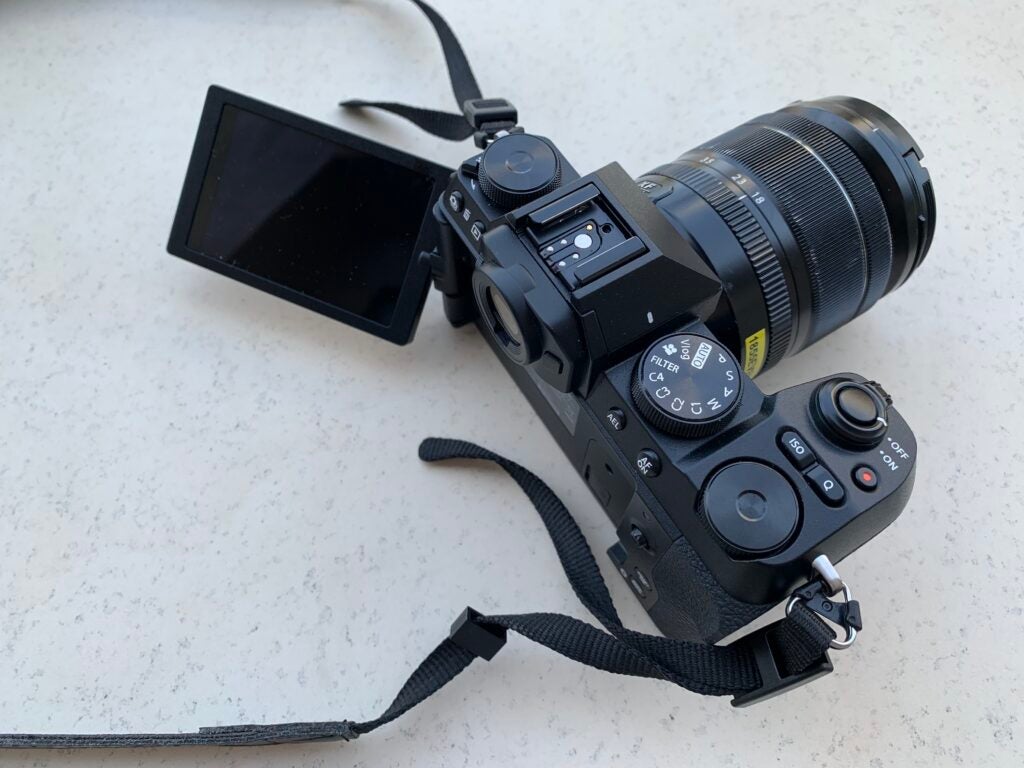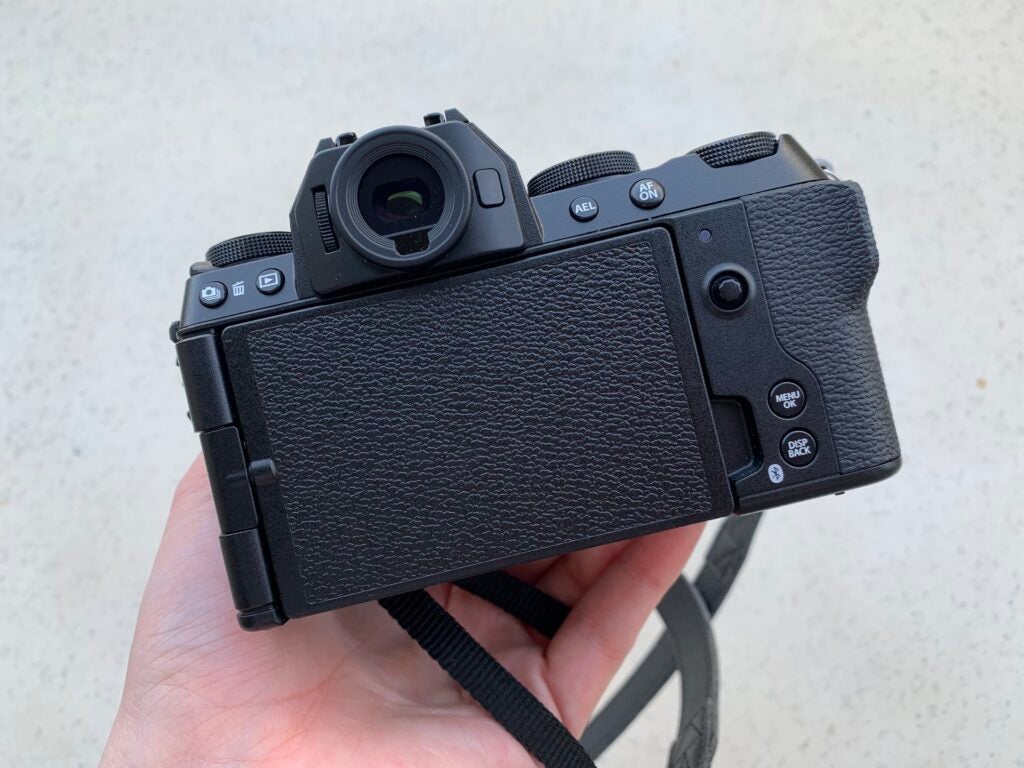First Impressions
The Fujifilm X-S20 is a brilliant camera at first glance, squeezing vibrant images and 6.2K video out of a slim and lightweight package. The controls can be a little fiddly, but the all-day battery and dedicated vlog mode have me impressed so far.
Availability
- UKRRP: £1249
- USARRP: $1299
-
26.1-megapixel stillsFujifilm X-Trans 4 CMOS sensor -
X-Processor 5Same image processor used in the X-T5 and X-H2 -
Subject tracking AF detects animals, birds, cars, motorcycles, bicycles, planes, trains and more -
6.2K/30p videoBuilt-in vlog mode brings features like Background Defocus and Product Priority
Introduction
Fujifilm recently updated its mirrorless camera line with a new mid-range option designed to replace the X-S10 that launched back in 2020.
The Fujifilm X-S20 will be particularly tempting for content creators thanks to its 6.2K video support and dedicated vlog mode that brings to the forefront some nifty new vlogging features. It’s also super slim and travel-friendly.
Fujifilm has confirmed that X-S20 will launch on 29th June 2023, with a recommended price of $1299 / £1249.
I had the opportunity to test the X-S20 firsthand on the streets of Malta this week. Scroll down for my first impressions of the latest Fujifilm camera.
Design and features
- The camera is slim and lightweight
- The monitor and EVF are bright
- The joystick can be quite fiddly
The Fujifilm X-S20 visually looks a lot like the X-S10 that came before it.
It has a slim, lightweight design with a deep rubber grip that feels comfortable to hold. There are also subtle ridges on the rear of the camera for the thumb to rest and on the front for the first finger when it isn’t pressing down on the shutter, which helped me feel I had a solid grip on the camera.

On the back, there’s a very limited number of controls, including a menu/ok button, a display/back button and a joystick for flicking through menus and moving the focus point. I found that the small size of the joystick made it quite fiddly to use at times, so I would personally prefer the option of an arrow pad along with the joystick – something Fujifilm currently offers on the X-T5, X-H2 and X-H2S. However, this is something that I think will come down to personal preference.
The majority of the controls can be found on the top edge of the camera. This includes the (separate) photo and video shutter buttons, mode dial, exposure compensation dial, flash trigger, AF, ISO, burst mode and playback button.

There’s an EVF that I found to be suitably bright, along with a sharp 3-way tilting display that flips out to snap selfies. This is also a handy feature for vloggers (as is the built-in vlog mode which I’ll touch on further down).
The camera takes a single SD card, though you’ll want to use a UHS-II card to take full advantage of the camera’s specs.

The X-S20 also has a lens mount, making the camera more versatile than one with a fixed lens. Other vlogging cameras that have a lens mount include the Sony ZV-E10 and the Nikon Z30, though you can often find cheaper models with a single fixed lens if you’re looking for a simpler setup.
Specs and performance
- The X-S20 features the same processor as the X-T5
- It can capture 26.1MP stills and 6.2K/30p video
- There’s a built-in vlog mode with subject detection
The Fujifilm X-S20 is powered by the X-Processor 5 image processor currently found inside the X-T5, X-H2 and X-H2S. However, it falls behind these cameras with a slightly dated X-Trans 4 sensor – the same found on the X-T4.
This combination enables the camera to capture 26.1-megapixel images and up to 6.2K/30p, including 4K/60p and 1080p/240p.

I found images and video produced by the X-S20 to be sharp and vibrant, with the colours popping straight out of camera and a solid amount of contrast and depth. I paired the camera with Fujifilm’s new 8mm lens (seen above) and a standard 18-55mm (all other images).
When it comes to video, there’s also support for Apple ProRes RAW and Blackmagic RAW when recording via HDMI and, most interestingly, a dedicated vlog mode built right into the top dial.
This offers vloggers fast access to new features like Background Defocus and Product Priority that I can certainly see proving useful for YouTubers, product reviewers and TikTok stars, in particular. The Product Priority mode appears to be Fujifilm’s answer to Sony’s own Product Showcase mode, so I’d be interested in comparing the two options in our full review.
The camera offers 7 stops of in-body stabilisation to combat shaky hands and has an ISO range of 160 to 12800, or 80 to 51200 extended.
I found the AF to be quite snappy and the subject tracking modes worked well when faced with people and animals, including several cats and people at quite a distance and in dark shadows. Other subject detection options include birds, cars, motorcycles, bicycles, planes, trains, insects and drones, so there’s quite a variety available.
I did sometimes encounter trouble adjusting the focus when the camera latched onto the wrong object, but the majority of the time it was spot on. However, this is definitely something I plan to explore further in our full review.

The X-S20 has an estimated battery life of 800 frames which is twice that found on the X-S10, suggesting you’ll see a big jump in endurance for the camera if you choose to upgrade.
I took the camera out for a full day of shooting RAW images and 4K video and found it ended the day at 50%, which was very impressive considering how much strain it was under.
Early Verdict
The Fujifilm X-S20 is a brilliant camera at first glance, squeezing vibrant images and 6.2K video out of a slim and lightweight package. The controls can be a little fiddly, but the all-day battery and dedicated vlog mode have me impressed so far.
Latest deals
UK RRP
USA RRP
Manufacturer
Video Recording
IP rating
Size (Dimensions)
Weight
Release Date
Autofocus
Burst shooting (mechanical shutter)
Burst shooting (electronic shutter)
Viewfinder
Screen
Image stabilisation
Wi-Fi
Bluetooth
Number of Memory card slots
USB charging
Microphone port
Headphone port
Lens mount
First Impressions
The Fujifilm X-S20 is a brilliant camera at first glance, squeezing vibrant images and 6.2K video out of a slim and lightweight package. The controls can be a little fiddly, but the all-day battery and dedicated vlog mode have me impressed so far.
Availability
- UKRRP: £1249
- USARRP: $1299
-
26.1-megapixel stillsFujifilm X-Trans 4 CMOS sensor -
X-Processor 5Same image processor used in the X-T5 and X-H2 -
Subject tracking AF detects animals, birds, cars, motorcycles, bicycles, planes, trains and more -
6.2K/30p videoBuilt-in vlog mode brings features like Background Defocus and Product Priority
Introduction
Fujifilm recently updated its mirrorless camera line with a new mid-range option designed to replace the X-S10 that launched back in 2020.
The Fujifilm X-S20 will be particularly tempting for content creators thanks to its 6.2K video support and dedicated vlog mode that brings to the forefront some nifty new vlogging features. It’s also super slim and travel-friendly.
Fujifilm has confirmed that X-S20 will launch on 29th June 2023, with a recommended price of $1299 / £1249.
I had the opportunity to test the X-S20 firsthand on the streets of Malta this week. Scroll down for my first impressions of the latest Fujifilm camera.
Design and features
- The camera is slim and lightweight
- The monitor and EVF are bright
- The joystick can be quite fiddly
The Fujifilm X-S20 visually looks a lot like the X-S10 that came before it.
It has a slim, lightweight design with a deep rubber grip that feels comfortable to hold. There are also subtle ridges on the rear of the camera for the thumb to rest and on the front for the first finger when it isn’t pressing down on the shutter, which helped me feel I had a solid grip on the camera.

On the back, there’s a very limited number of controls, including a menu/ok button, a display/back button and a joystick for flicking through menus and moving the focus point. I found that the small size of the joystick made it quite fiddly to use at times, so I would personally prefer the option of an arrow pad along with the joystick – something Fujifilm currently offers on the X-T5, X-H2 and X-H2S. However, this is something that I think will come down to personal preference.
The majority of the controls can be found on the top edge of the camera. This includes the (separate) photo and video shutter buttons, mode dial, exposure compensation dial, flash trigger, AF, ISO, burst mode and playback button.

There’s an EVF that I found to be suitably bright, along with a sharp 3-way tilting display that flips out to snap selfies. This is also a handy feature for vloggers (as is the built-in vlog mode which I’ll touch on further down).
The camera takes a single SD card, though you’ll want to use a UHS-II card to take full advantage of the camera’s specs.

The X-S20 also has a lens mount, making the camera more versatile than one with a fixed lens. Other vlogging cameras that have a lens mount include the Sony ZV-E10 and the Nikon Z30, though you can often find cheaper models with a single fixed lens if you’re looking for a simpler setup.
Specs and performance
- The X-S20 features the same processor as the X-T5
- It can capture 26.1MP stills and 6.2K/30p video
- There’s a built-in vlog mode with subject detection
The Fujifilm X-S20 is powered by the X-Processor 5 image processor currently found inside the X-T5, X-H2 and X-H2S. However, it falls behind these cameras with a slightly dated X-Trans 4 sensor – the same found on the X-T4.
This combination enables the camera to capture 26.1-megapixel images and up to 6.2K/30p, including 4K/60p and 1080p/240p.

I found images and video produced by the X-S20 to be sharp and vibrant, with the colours popping straight out of camera and a solid amount of contrast and depth. I paired the camera with Fujifilm’s new 8mm lens (seen above) and a standard 18-55mm (all other images).
When it comes to video, there’s also support for Apple ProRes RAW and Blackmagic RAW when recording via HDMI and, most interestingly, a dedicated vlog mode built right into the top dial.
This offers vloggers fast access to new features like Background Defocus and Product Priority that I can certainly see proving useful for YouTubers, product reviewers and TikTok stars, in particular. The Product Priority mode appears to be Fujifilm’s answer to Sony’s own Product Showcase mode, so I’d be interested in comparing the two options in our full review.
The camera offers 7 stops of in-body stabilisation to combat shaky hands and has an ISO range of 160 to 12800, or 80 to 51200 extended.
I found the AF to be quite snappy and the subject tracking modes worked well when faced with people and animals, including several cats and people at quite a distance and in dark shadows. Other subject detection options include birds, cars, motorcycles, bicycles, planes, trains, insects and drones, so there’s quite a variety available.
I did sometimes encounter trouble adjusting the focus when the camera latched onto the wrong object, but the majority of the time it was spot on. However, this is definitely something I plan to explore further in our full review.

The X-S20 has an estimated battery life of 800 frames which is twice that found on the X-S10, suggesting you’ll see a big jump in endurance for the camera if you choose to upgrade.
I took the camera out for a full day of shooting RAW images and 4K video and found it ended the day at 50%, which was very impressive considering how much strain it was under.
Early Verdict
The Fujifilm X-S20 is a brilliant camera at first glance, squeezing vibrant images and 6.2K video out of a slim and lightweight package. The controls can be a little fiddly, but the all-day battery and dedicated vlog mode have me impressed so far.
Latest deals
UK RRP
USA RRP
Manufacturer
Video Recording
IP rating
Size (Dimensions)
Weight
Release Date
Autofocus
Burst shooting (mechanical shutter)
Burst shooting (electronic shutter)
Viewfinder
Screen
Image stabilisation
Wi-Fi
Bluetooth
Number of Memory card slots
USB charging
Microphone port
Headphone port
Lens mount
























